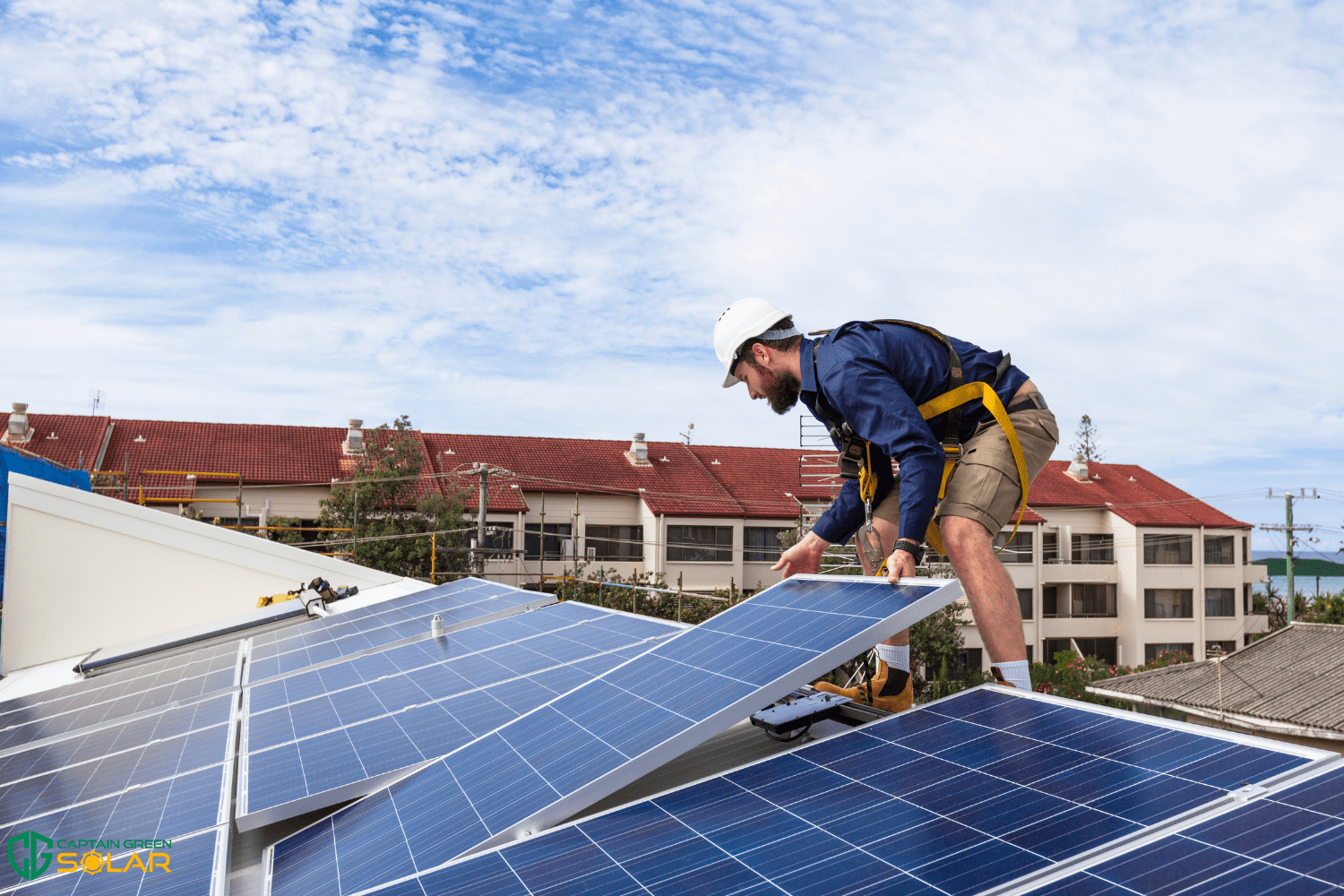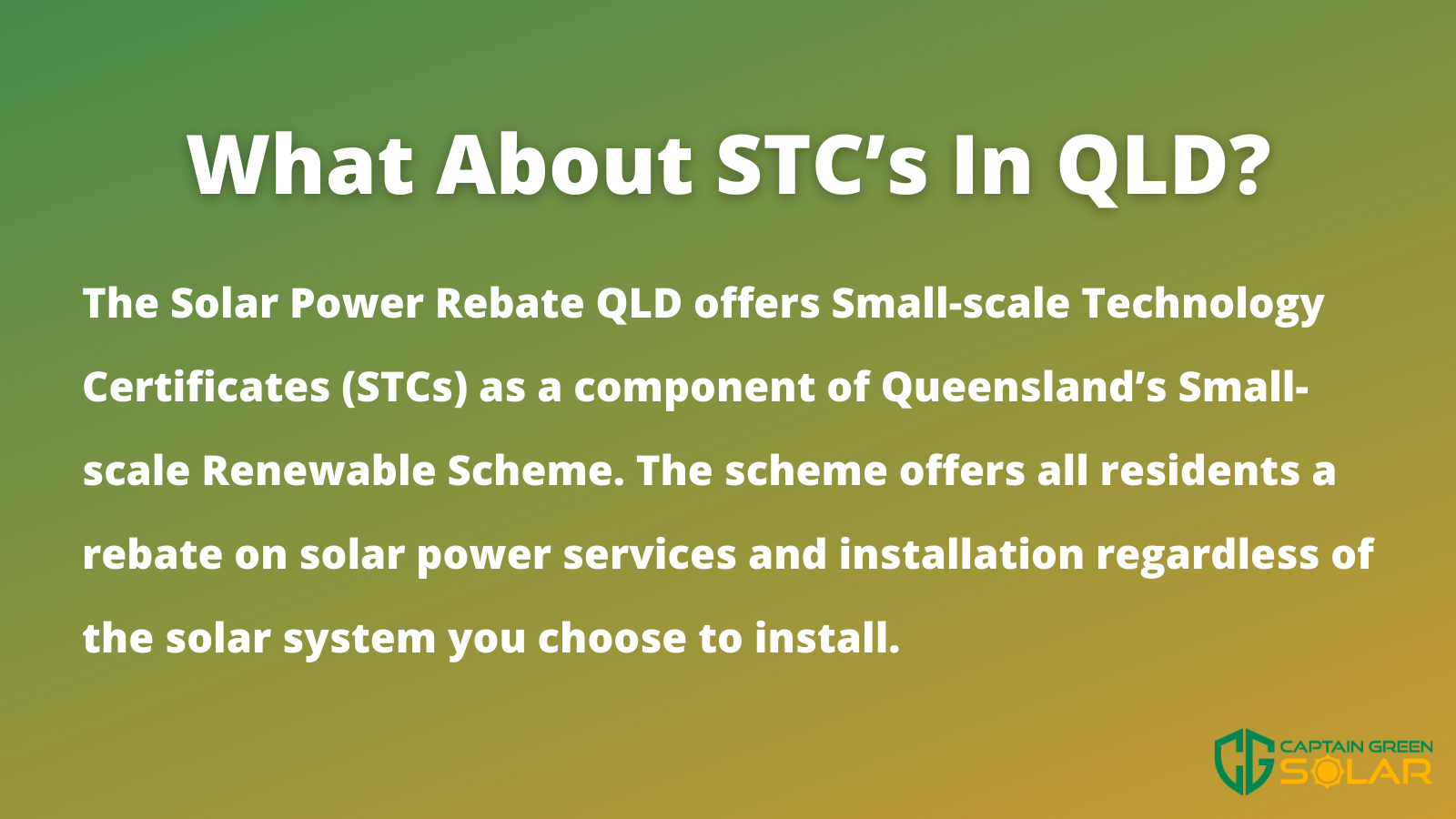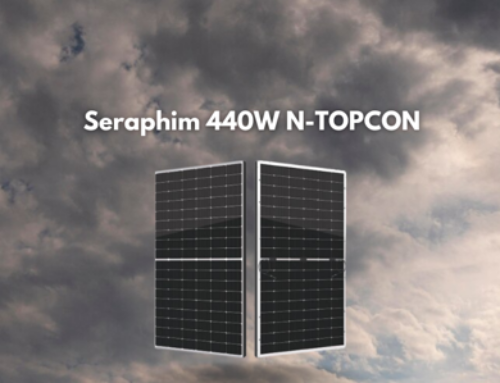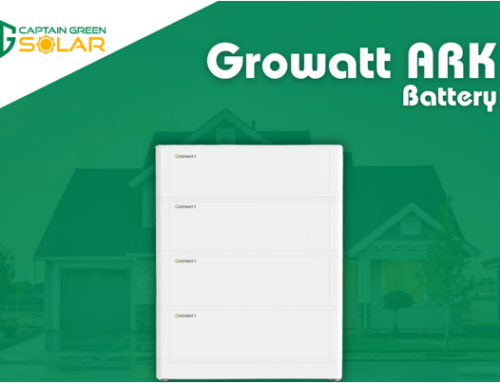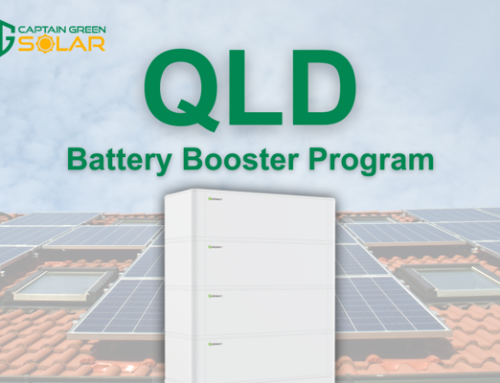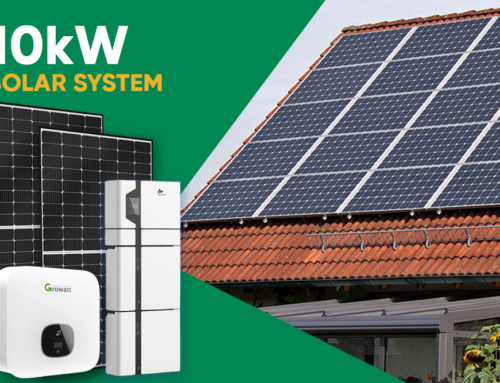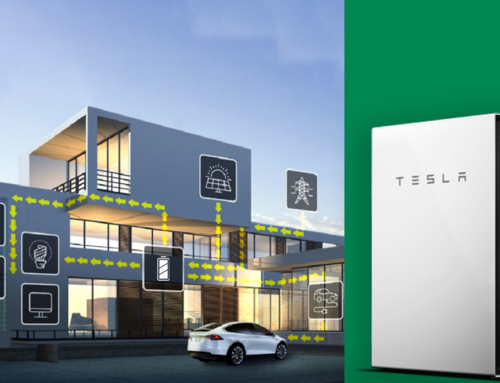Looking to move to solar for your QLD property but want to ensure you’re making the most of the rebates? Captain Green are here to help.
The Solar Rebate Qld is an initiative that makes it easier and cheaper for residents of Queensland wanting to go solar, cutting installation costs by roughly a third.
Solar Power Rebates in Queensland encourage residents of the sunshine state to maximise on those rays by incentivising clean energy. There are two key means in which you can recover the costs of setting up your solar power system with rebates. Firstly, where the costs of service and installation are mitigated through Small-scale Technology Certificates (STCs), and secondly, with feed-in tariffs. Your eligibility will often depend on your location and place of residency.
How Much Is the Solar Panel Rebate QLD?
The most popular solar system in Queensland is 5 kilowatt-hours, and with the Solar Rebate QLD, each household is entitled to $4,215 on average to go towards its installation. The average rebate offers a third of the price reduction.
An example would be: If a resident was installing a common solar system such as a 5Kw system, they might receive around 89 small-scale technology certificates (STCs) in return and roughly $3,514 in rebates. This estimate will vary depending on the value of the STC market, at the time of reading this article.
The sum of your Queensland Solar Rebate will be contingent on several factors and can be calculated by your system size, your location, and current STC market prices.
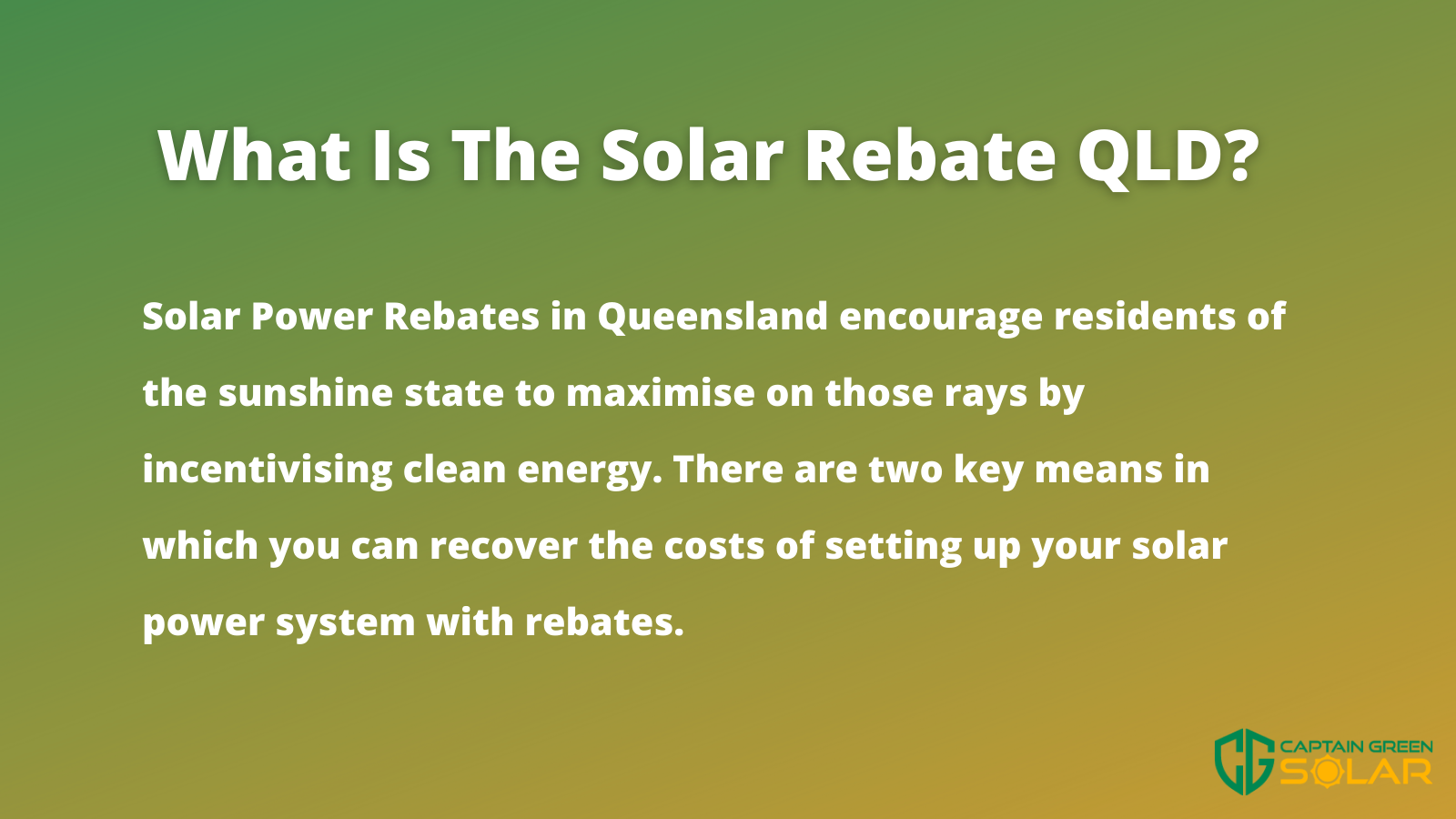
The solar rebate is not available on a state level.
Am I Eligible for the Solar Power Rebate in QLD?
The sunshine state incentivises solar power for almost everyone, meaning, as a resident of QLD, you are most likely eligible for the Queensland solar rebate. On a national level, the Australian Government launched the small-scale renewable energy target (RET program), as part of a solar rebate scheme. While Australia is currently ranking the highest in the world for solar power uptake, the government aims to achieve close to 100% solar power usage nation-wide.
Unlike other schemes, almost everyone is eligible. Make sure to install your solar system with a Clean Energy Council Accredited Installer (like Captain Green Solar!), in Queensland. The solar panels and inverters you use must also be approved by the CEC and adhere to Australian and New Zealand criteria.
Conditions, as outlined by the CEC, are:
- You must be the primary owner of the place of residence you wish to have solar power installed, and have the necessary documentation to prove your ownership.
- Solar systems installed do not exceed 1000W nominal capacity and a 250Mwh yearly production.
- Solar systems are fitted within 12 months of claiming any STCs. This can be easier if the right to claim is given to the solar company at the onset.
What About STC’s in QLD?
The Solar Power Rebate QLD offers Small-scale Technology Certificates (STCs) as a component of Queensland’s Small-scale Renewable Scheme. The scheme offers all residents a rebate on solar power services and installation regardless of the solar system you choose to install. You can obtain certificates that can be traded on the open market or given to your solar installer so that you can receive lower installation costs.
While you can choose to trade STCs yourself, it may be easier if you assign the right to claim over to your solar power installer at the point of sale. They can give you a discount upfront.
The price of an STC relies on the cost of carbon. Costs are subject to fluctuation due to supply and demand. However, on average, the prices often sit between the $35 and $40 mark.
Other QLD Government Solar Invectives
There are several different ways you can pay for solar installation in Queensland.
While the cheapest option is to purchase a solar system outright, you may encounter issues associated with a warranty, contracts, and associated costs down the line.
You can pay the cost of your installation over time with a solar power purchase agreement which will require two different bills- solar power and electricity usage. Your provider will install, operate, maintain and own your system. You may incur an increase in costs over time and be required to purchase all the energy you produce. This could result in a decreased value and return on your electricity sold back to the grid.
A solar loan will eliminate upfront costs. Once you have made your repayments over a contract course of generally 2-5 years, you may be able to own your system at the end. This could put you at risk of maintenance and repair costs not covered by your warranty.
Leasing a solar power system means a higher overall cost, but removes the need for upfront payment. You pay separately for grid power and lease payments. Ensure you have insurance, so you are not liable for payments if your system is ever broken or damaged.
Some ways in which you may determine what payment path is right for you is by considering several key factors.
Consider your:
- Energy usage
- The price of the kilowatt-hour
- Whether you are charged for your entire energy output
- Whether you need insurance
- The terms of your insurance
- Other associated costs
- Termination fees and options for an agreement
- Your options at the end of your agreement
We advise you to evaluate the different options and obtain a few quotes before landing on the right payment path for you.
Choosing the Right QLD Solar Feed-In Tariff
A feed-in tariff is like a recycling scheme for your surplus electricity. The excess electricity produced by your solar system and not used by your household, can be sold back to the shared energy grid. The grid refers to a complex transmission network that supplies electricity to homes and businesses across Australia from power plants.
Feed-in tariffs can give you discounted electricity bills as well as an increase in the return on your solar investments. Extra kilowatt-hours are valuable, so high feed-in tariffs encourage homeowners to install larger solar systems to benefit financially from their unused electricity output.
The Queensland government offers different feed-in tariffs depending on your location. For instance, if you are a regional resident, you have access to a regional feed-in tariff. If you are based in South East Queensland, you have access to a market feed-in tariff, direct from your electricity provider. Confirm you have a grid-connected solar PV system and one that ideally has a higher production volume than what you require.
For those in Brisbane and other areas of South East Queensland, you stand to gain a lot back with a high feed-in tariff rate as there is likely no minimum on what your energy providers must adhere to.
So, if you’re wondering who has the best Solar feed-in tariff in Queensland, here are some electricity retailers offering great rates as measured by cents per kilowatt-hour (c/kWh) in 2021:
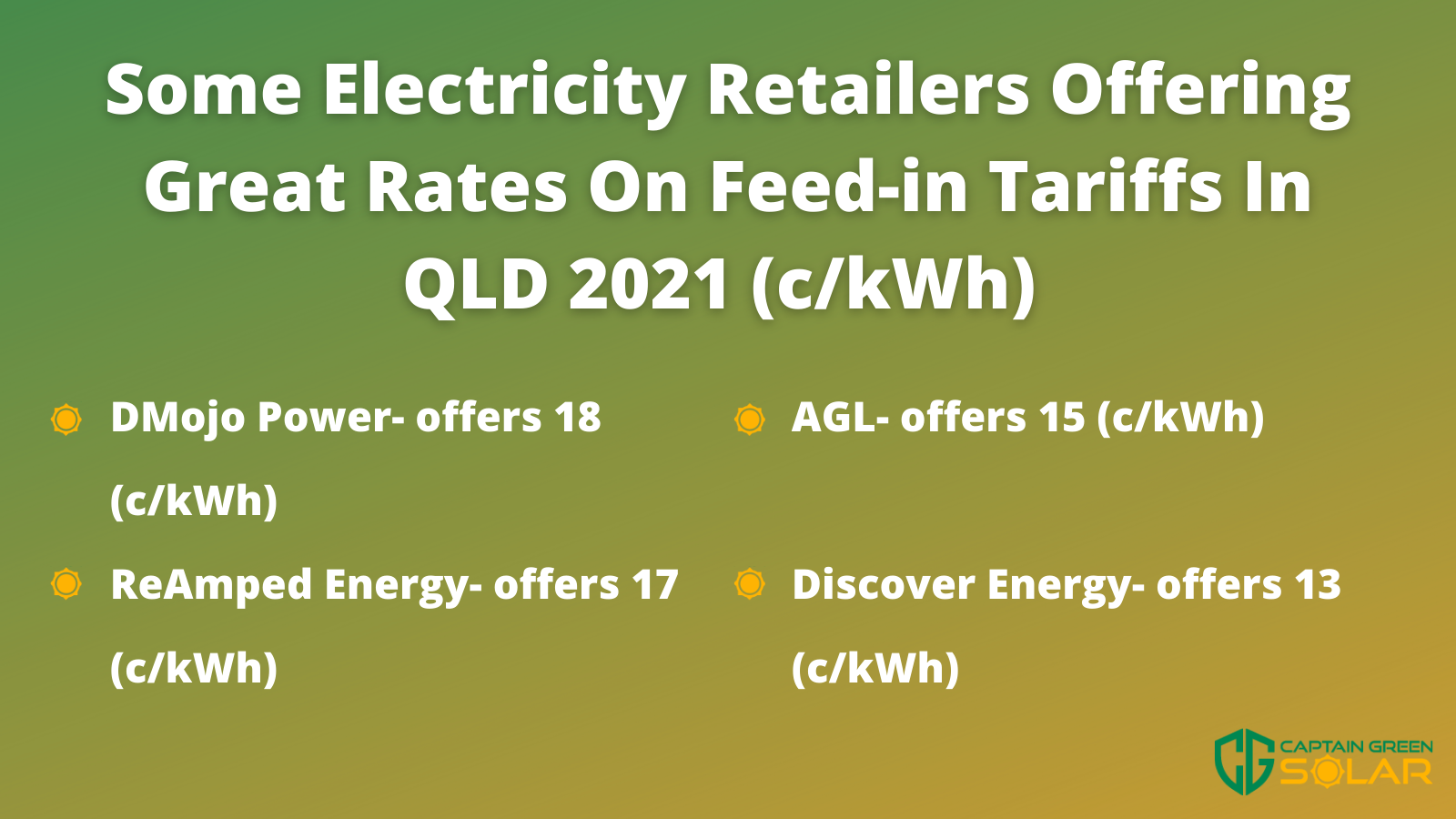
Mojo Power– offers 18 (c/kWh)
ReAmped Energy– offers 17 (c/kWh)
AGL– offers 15 (c/kWh)
Discover Energy– offers 13 (c/kWh)
Please note that this information is subject to change as rates fluctuate.
Are QLD solar feed-in tariffs worth it? Absolutely. Most electricity providers offer feed-in tariffs, making solar power appealing to many. Ensure you find the best solar feed-in tariff for you that lowers your electricity bills and offers a great rate on your exported solar power.
So, what should you base your decision on? Weigh up whether high solar feed-in tariff rates or low electricity rates are better for you by evaluating your situation and usage habits.
How Do I Apply for the Solar Rebate QLD?
You do not need to process an application for the Solar Rebate yourself. The rebate amount is factored in by your solar installer, at the point of sale. This is why solar is relatively inexpensive and attractive to Queensland residents.
Speak to a Solar Expert Today
At Captain Green Solar, we have proudly installed over 270,000 solar panels in Australia to date. If you are a Queensland resident and ready to make the switch to solar energy, get a quote today by sending us a message online or give our friendly team a call on 1300 361 682.

